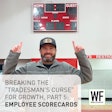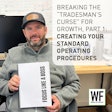
 These customers changed from soft-spoken, wonderful people to angry children.
These customers changed from soft-spoken, wonderful people to angry children.
1) Talk about another man’s wife in a disparaging manner.
2) Mess with a man’s money.
These are two essential basics I learned as a young man. I hope the first is entirely avoided—instinctively. But the second has some legs I can speak on. Regarding our trade, when we complete a contract and do not go home with full payment, there is usually a reason. Either we as business owners agreed on this in advance, or we are being clowned by the customer—and that leads to all kinds of problems (I talked about some of them in my last blog, “How I Combat the Common Excuses for Customers Not Paying”).
Despite all my efforts mentioned in the last blog, I am not immune. As recently as last June, I went through this. Here is my story.
I was chosen to install 1,200 square feet of the customer’s ½-by-6-inch engineered flooring in their unfinished custom home. I would have like to have supplied the material, but that didn't work out. I was merely the labor part of the contract.
It was a huge house, and the flooring was being installed upstairs only—over plywood. It was a sweet install. Think of the high points:
1) Prefinished
2) Nail-down
3) Plywood subfloor
4) 6-inch widths
5) Hardly any prep
6) No molding
7) 1,200 feet
We finished this install in four days, and it was late in the day, so we all went home. The next day was pay day, and I had Friday off! I had another job starting the next Monday, so the Friday off was like a gift, because I had the time to prepare. It was a peaceful night, with no phone calls or texts from the homeowners.
So I texted in the morning and asked when was a good time to arrive, and the wife said “anytime,” so when I got to the job about an hour later, I had no clue as to the concerns she held. For starters, it was all excuses. One “fault” she threw at me was marks on the door jambs from power cords and air hoses. Another was deep dents in one of the casings as if from a prybar repeatedly hammered into the hinge side of the jamb. Lastly, a small bit of filler needed to be pushed into a few face nails holes along a certain wall.
Then she stopped, and the context of this part of the conversation was, “We are not paying for this.”
I fought back, but did it with restraint. If not for restraint, I would’ve had to resort to court. These customers changed from soft-spoken, wonderful people to angry children, and I had to either control the situation or allow them to control it.
I chose to control it.
Now imagine teams of other trades in our path the whole time we were working. I took pictures through the job and compared them to the marks on the door jambs, and none of them fit our methods or our tools. Did that matter? Of course not.
Then the deep dents in one of the jambs … the “dents” were painted over. Painters had painted all the jambs before we even started, and there was no way the deep dents could be made without damaging the new paint. Did that matter? Of course not.
The face-nail holes I filled on the spot. Did that matter? Of course not.
It all ended with compromise. I had a few choices, and weighed them carefully. Keeping my target goal of walking out with my money my primary concern. Why? Because this was the most profitable path. This customer probably used this fake strategy on their part to put a hedge up against the tremendous amount of money they were spending to build this home. You may not know it, but building a custom home in Los Angeles county is like walking a prehistoric Amazonian rope bridge you find in the middle of the jungle—suspended over a 1,000-foot chasm. There are so many hoops to jump through: kickbacks to the building inspector, bribes to the building department, fire department codes they didn’t know about, etc.
So, I could kinda see where they were coming from—unethical as it was, I understood it.
I asked, “How much will it cost to clean up the power cord and air hose marks on the jambs, and smooth out the deep dents in that one doorway?” The lady stopped, thought about it and said $500.
I said, “Fine, if we take $500 off the contract are we good?” and the lady said “Yes.”
It was a silly solution to a make-believe problem, and I resented it.
I walked out with a check and never looked back. It was a silly solution to a make-believe problem, and I resented it. I cashed the check immediately in case their decision changed quickly—I intended to be quicker.
I don’t like playing this game, mostly because I question why people aren’t more honest to begin with, but here it is, and it’s normal life. You’d think playing with money wouldn’t be a thing – but it is. Sometimes I don’t win and must wait, but not without a sincere effort. In that case, I take a legal inventory of my posture and gather up my strengths and check them off one at a time. If I am righteous, I am first in line at the courthouse. In this case, I learned something about job-site pre-existing conditions. I should’ve taken more cell phone pics of the critical aspects of the job. Even though I had about 400 pics of that job when it was over, I never thought of taking pics “before” we started. On our very next install I did just that. I pointed out to that customer, “I didn’t do that,” and it was received well.
There are all sorts of reasons for not getting paid, and this was just one. With a different job it may be insolvency of the customer, or the lame excuse, “We went out of town for a couple weeks, we’ll pay you when we get back.” These are both scenarios that can be dealt with beforehand. I would hope that all contractors put the customers to task for their end – payment - and ask those difficult questions. In this case, I avoided a lengthy court battle and was able to read the customer and formulate a solution to my benefit. It was not a perfect solution, but I learned from it.
See all of Angelo DeSanto's popular blog posts and magazine articles here.


































